Analysis of Tensile Strength and Failure Mechanism Based on Parallel Homogenization Model for Recycled Concrete
Abstract
:1. Introduction
2. Materials and Methods
2.1. Random Aggregate Model
2.2. Parallel Homogenization Model
2.2.1. Parallel Homogenization Model
2.2.2. Finite Element Meshing and Homogenization
2.2.3. Damage Model
3. Calculation Results
3.1. Uniaxial Tensile Loading Model
3.2. Numerical Simulation Results
4. Discussion
5. Conclusions
Author Contributions
Funding
Institutional Review Board Statement
Informed Consent Statement
Data Availability Statement
Conflicts of Interest
References
- Tam, V.W.Y.; Soomro, M.; Evangelista, A.C.J. A review of recycled aggregate in concrete applications (2000–2017). Constr. Build. Mater. 2018, 172, 272–292. [Google Scholar] [CrossRef]
- Eguchi, K.; Teranishi, K.; Narikawa, M. Study on mechanism of drying shrinkage and water loss of recycled aggregate concrete. J. Struct. Constr. Eng. 2003, 68, 1–7. [Google Scholar] [CrossRef]
- Park, S.B.; Seo, D.S.; Lee, J. Studies on the sound absorption characteristics of porous concrete based on the content of recycled aggregate and target void ratio. Cem. Concr. Res. 2005, 35, 1846–1854. [Google Scholar] [CrossRef]
- Brito, J.D.; Ferreira, J.; Pacheco, J.; Soares, D.; Guerreiro, M. Structural, material, mechanical and durability properties and behaviour of recycled aggregates concrete. J. Build. Eng. 2016, 6, 1–16. [Google Scholar] [CrossRef]
- Shahidan, S.; Azmi, M.A.M.; Kupusamy, K.; Zuki, S.S.M.; Ali, N. Utilizing construction and demolition waste as recycled aggregates in concrete. Procedia Eng. 2017, 174, 1028–1035. [Google Scholar] [CrossRef]
- Xiao, J.Z; Li, W.G.; Corr, J.D.; Shah, P.S. Effects of interfacial transition zones on the stress–strain behavior of modeled recycled aggregate concrete. Cem. Concr. Res. 2013, 52, 82–99. [Google Scholar] [CrossRef]
- Guo, M.H.; Grondin, F.; Loukili, A. Numerical analysis of the failure of recycled aggregate concrete by considering the random composition of old attached mortar. J. Build. Eng. 2020, 28, 101040. [Google Scholar] [CrossRef]
- Ying, L.P.; Peng, Y.J; Kamel, M.M.A. Mesoscopic numerical analysis of dynamic tensile fracture of recycled concrete, Eng. Comput. 2020, 37, 1899–1922. [Google Scholar]
- Wang, Y.; Peng, Y.J.; Kamel, M.M.A.; Gong, L.Q. Modeling interfacial transition zone of RAC based on a degenerate element of BFEM. Constr. Build. Mater. 2020, 252, 119063. [Google Scholar] [CrossRef]
- Wang, Y.; Peng, Y.J.; Kamel, M.M.A.; Ying, L.P. Base force element method based on complementary energy principle for damage analysis of recycled aggregate concrete. Int. J. Numer. Meth. Eng. 2020, 121, 1484–1506. [Google Scholar] [CrossRef]
- Ying, L.P.; Peng, Y.J.; Yang, H.M. Meso-analysis of dynamic compressive behavior of recycled aggregate concrete using BFEM. Int. J. Comp. Meth. 2020, 17, 1950013. [Google Scholar] [CrossRef]
- Choubey, R.K.; Kumar, S.; Rao, M.C. Modeling of fracture parameters for crack propagation in recycled aggregate concrete. Constr. Build. Mater. 2016, 106, 168–178. [Google Scholar] [CrossRef]
- Wang, C.; Wu, Y.H.; Xiao, J.Z. Three-scale stochastic homogenization of elastic recycled aggregate concrete based on nano-indentation digital images. Front. Struct. Civ. Eng. 2017, 12, 461–473. [Google Scholar] [CrossRef]
- Anuruddha, J.; Adams, M.P.; Bandelt, M.J. Understanding variability in recycled aggregate concrete mechanical properties through numerical simulation and statistical evaluation. Constr. Build. Mater. 2018, 178, 301–312. [Google Scholar]
- Thomas, J.; Thaickavil, N.N.; Wilson, P.M. Strength and durability of concrete containing recycled concrete aggregates. J. Build. Eng. 2018, 19, 349–365. [Google Scholar] [CrossRef]
- Tan, X.; Li, W.G.; Zhao, M.H.; Tam, V.W.Y. Numerical Discrete-Element Method Investigation on Failure Process of Recycled Aggregate Concrete. J. Mater. Civ. Eng. 2019, 31, 04018353. [Google Scholar] [CrossRef]
- Guo, M.H.; Grondin, F.; Loukili, A. Numerical method to model the creep of recycled aggregate concrete by considering the old attached mortar. Cem. Concr. Res. 2019, 118, 14–24. [Google Scholar] [CrossRef]
- Kazemian, F.; Rooholamini, H.; Hassani, A. Mechanical and fracture properties of concrete containing treated and untreated recycled concrete aggregates. Constr. Build. Mater. 2019, 209, 690–700. [Google Scholar] [CrossRef]
- Wang, C.H.; Xiao, J.Z.; Zhang, G.Z.; Li, L. Interfacial properties of modeled recycled aggregate concrete modified by carbonation. Constr. Build. Mater. 2016, 105, 307–320. [Google Scholar] [CrossRef]
- Zhan, B.J.; Xuan, D.X.; Poon, C.S.; Scrivener, K.L. Characterization of interfacial transition zone in concrete prepared with carbonated modeled recycled concrete aggregates. Cem. Concr. Res. 2020, 136, 106175. [Google Scholar] [CrossRef]
- Verian, K.P.; Ashraf, W.; Cao, Y. Properties of recycled concrete aggregate and their influence in new concrete production. Resour Conserv Recycl. 2018, 133, 30–49. [Google Scholar] [CrossRef]
- Xue, C.; Li, W.; Li, J.; Wang, K. Numerical investigation on interface crack initiation and propagation behaviour of self-healing cementitious materials. Cem. Concr. Res. 2019, 122, 1–16. [Google Scholar] [CrossRef]
- Nitka, M.; Tejchman, J. Meso-mechanical modelling of damage in concrete using discrete element method with porous ITZs of defined width around aggregates. Eng. Fract. Mech. 2020, 231, 107029. [Google Scholar] [CrossRef]
- Nodehi, M. A comparative review on foam-based versus lightweight aggregate-based alkali-activated materials and geopolymer. Innov. Infrastruct. Solut. 2021, 6, 231. [Google Scholar] [CrossRef]
- Nodehi, M.; Aguayo, F. Ultra high performance and high strength geopolymer concrete. J. Build. Rehabil. 2021, 6, 34. [Google Scholar] [CrossRef]
- Nodehi, M.; Nodehi, S.E. Ultra high performance concrete (UHPC): Reactive powder concrete, slurry infiltrated fiber concrete and superabsorbent polymer concrete. Innov. Infrastruct. Solut. 2022, 7, 39. [Google Scholar] [CrossRef]
- Hudson, J.A.; Brown, E.T.; Fairhurst, C. Shape of the Complete Stress-Strain Curve for Rock. Proceedings of the 13th Symposium on Rock Mechanics; University of Illinois: Urbana, IL, USA, 1971. [Google Scholar]
- Bažant, Z.P.; Chang, T.P. Is Strain-Softening Mathematically Admissible? In Unknown Host Publication Title; ASCE: Reston, VA, USA, 1984. [Google Scholar]
- Boresi, A. P.; Chong, K.P. Elasticity in Engineering Mechanics; John Wiley & Sons: New York, Ny, USA, 2000. [Google Scholar]
- Ferretti, E. Shape-effect in the effective laws of plain and rubberized concrete. CMC-Comput. Mater. Contin. 2012, 30, 237–284. [Google Scholar]
- Zhu, W.C.; Tang, C.A.; Wang, S.Y. Numerical study on the influence of mesomechanical properties on macroscopic fracture of concrete. Struct. Eng. Mech. 2005, 19, 519–533. [Google Scholar] [CrossRef]
- Xiao, J.Z.; Lan, Y. Investigation on the tensile behavior of recycled aggregate concrete. J. Build. Mater. 2006, 2, 154–158. (in Chinese). [Google Scholar]
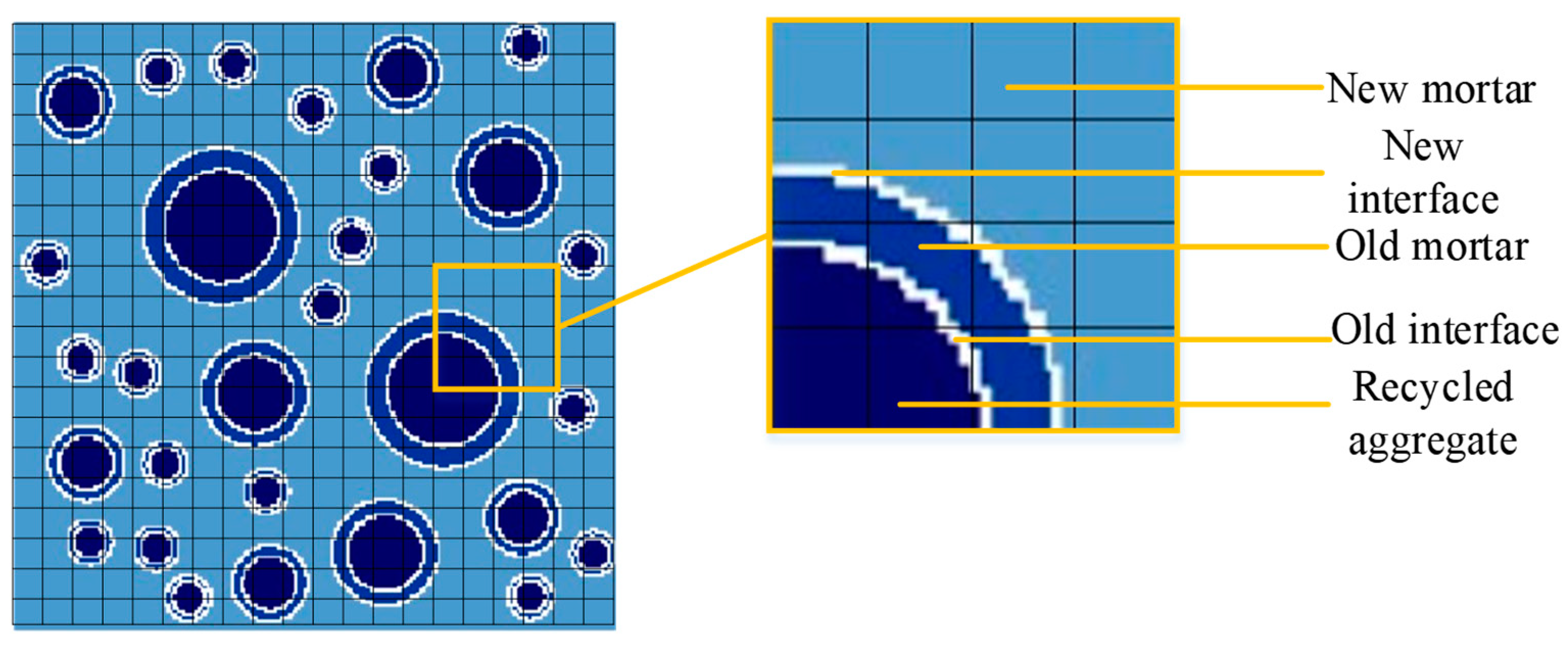
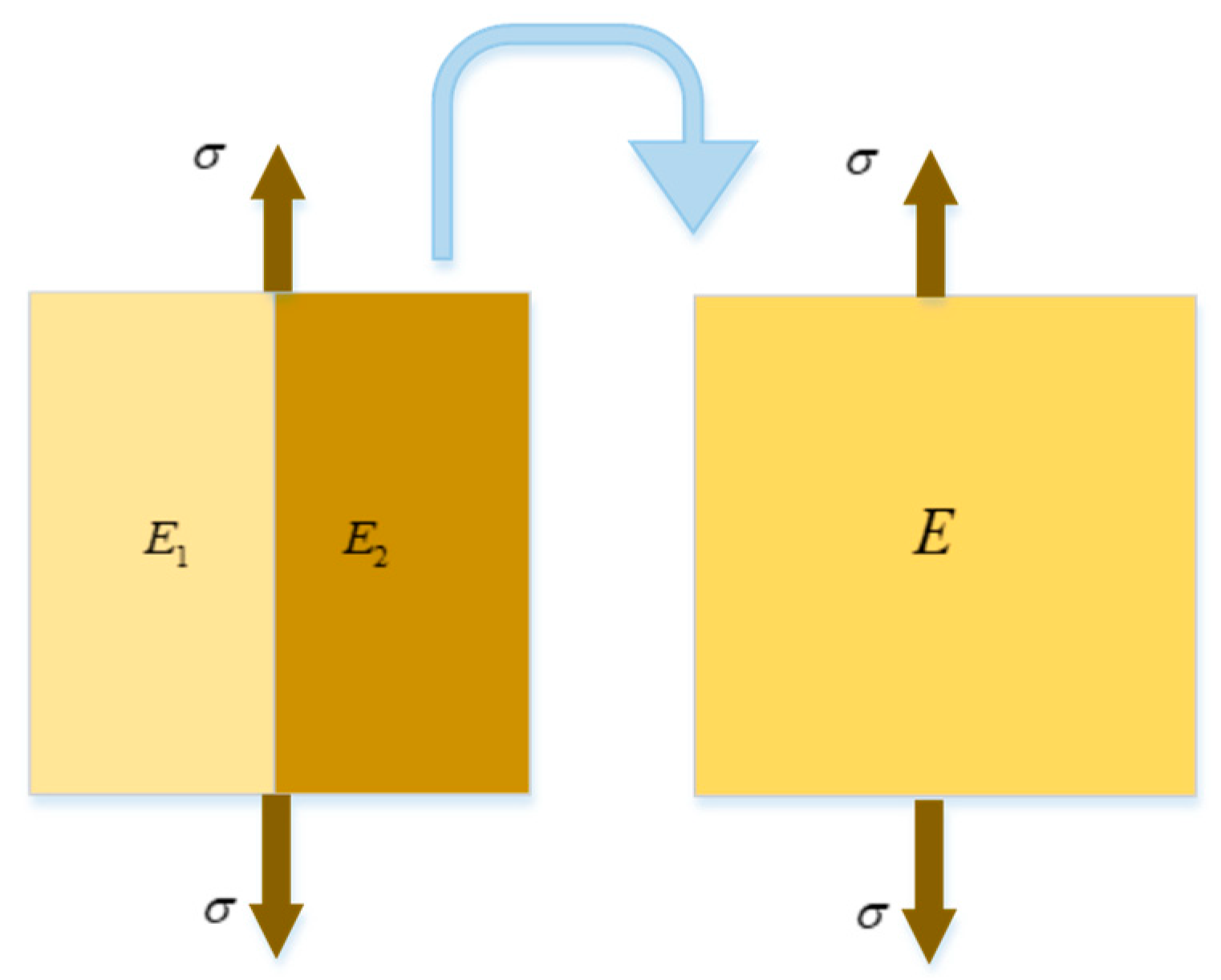
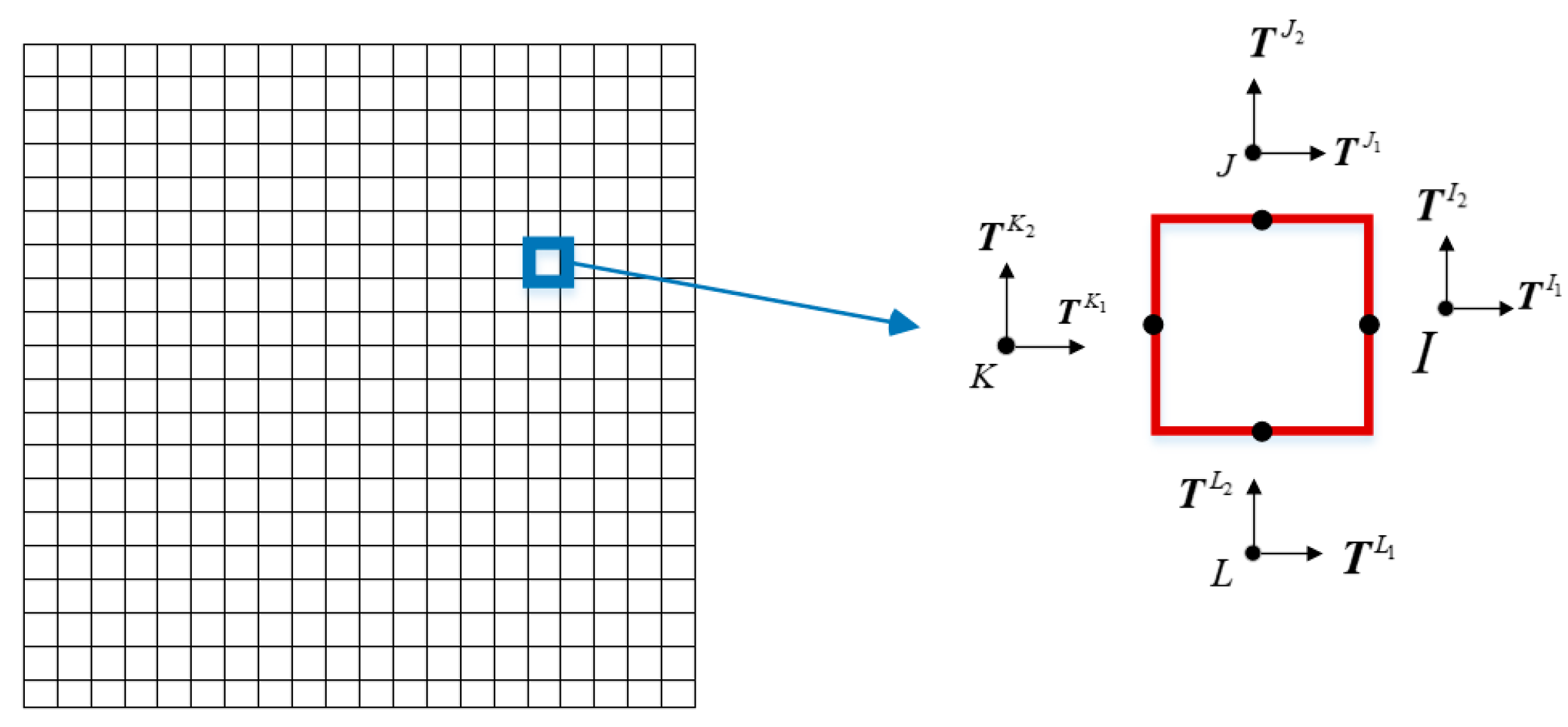
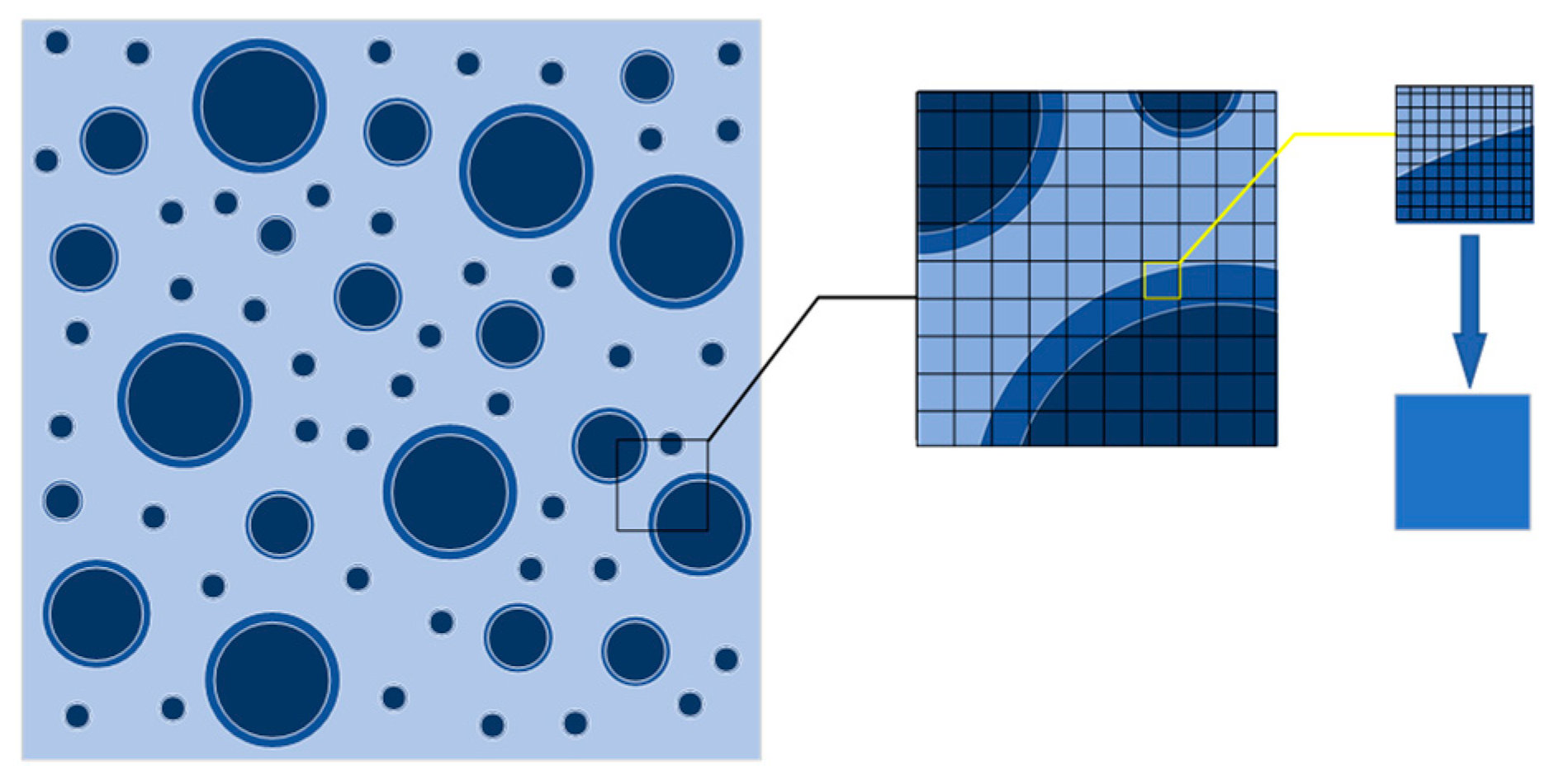
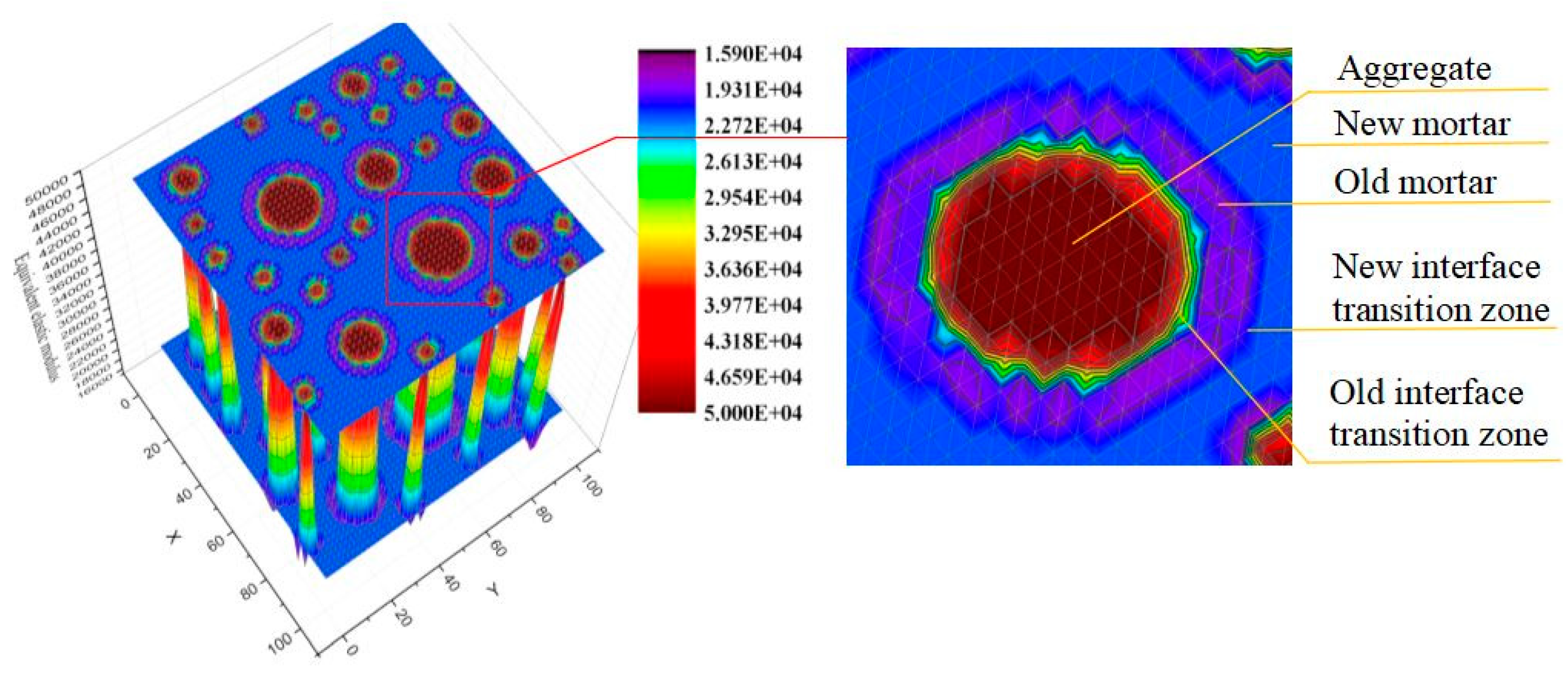
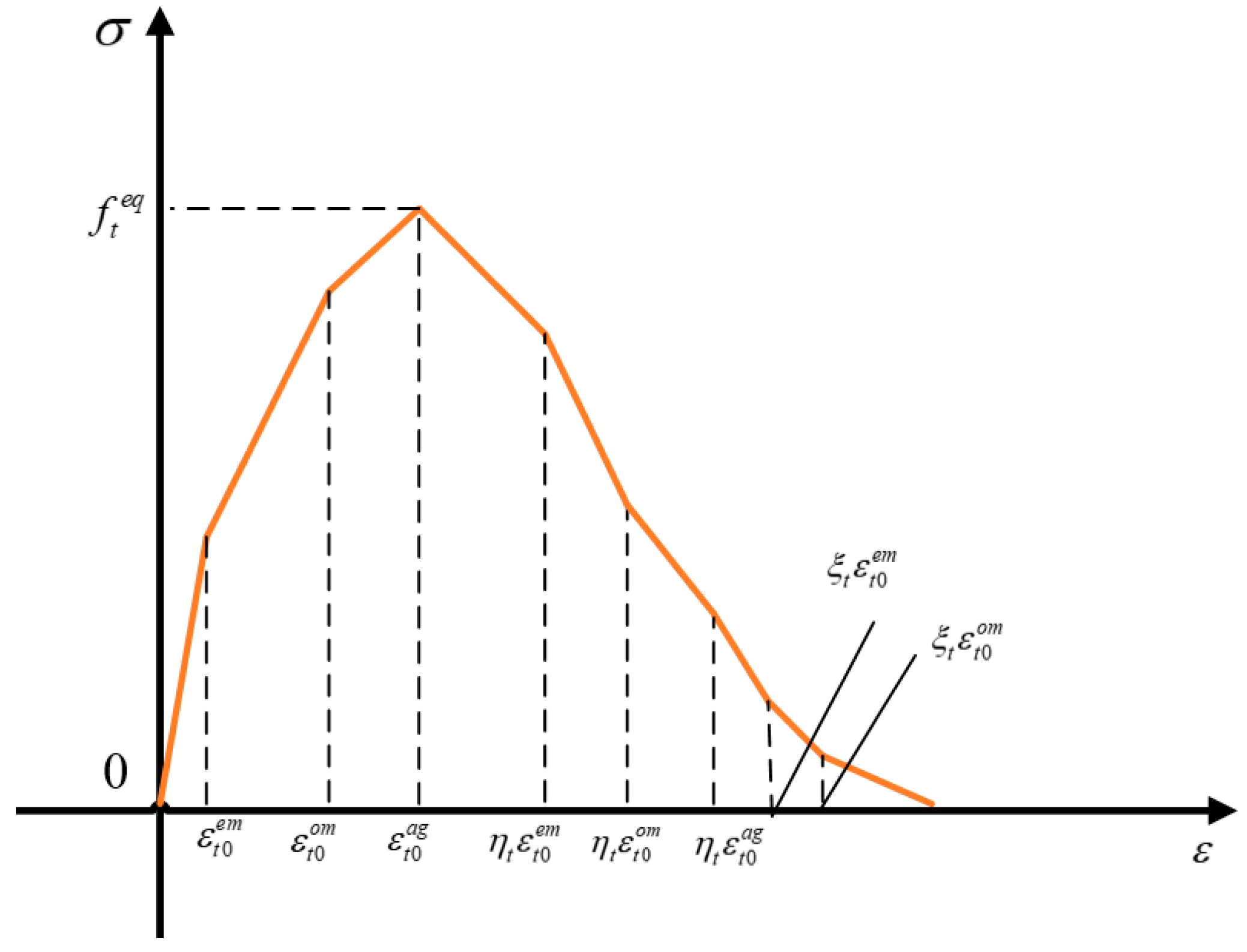
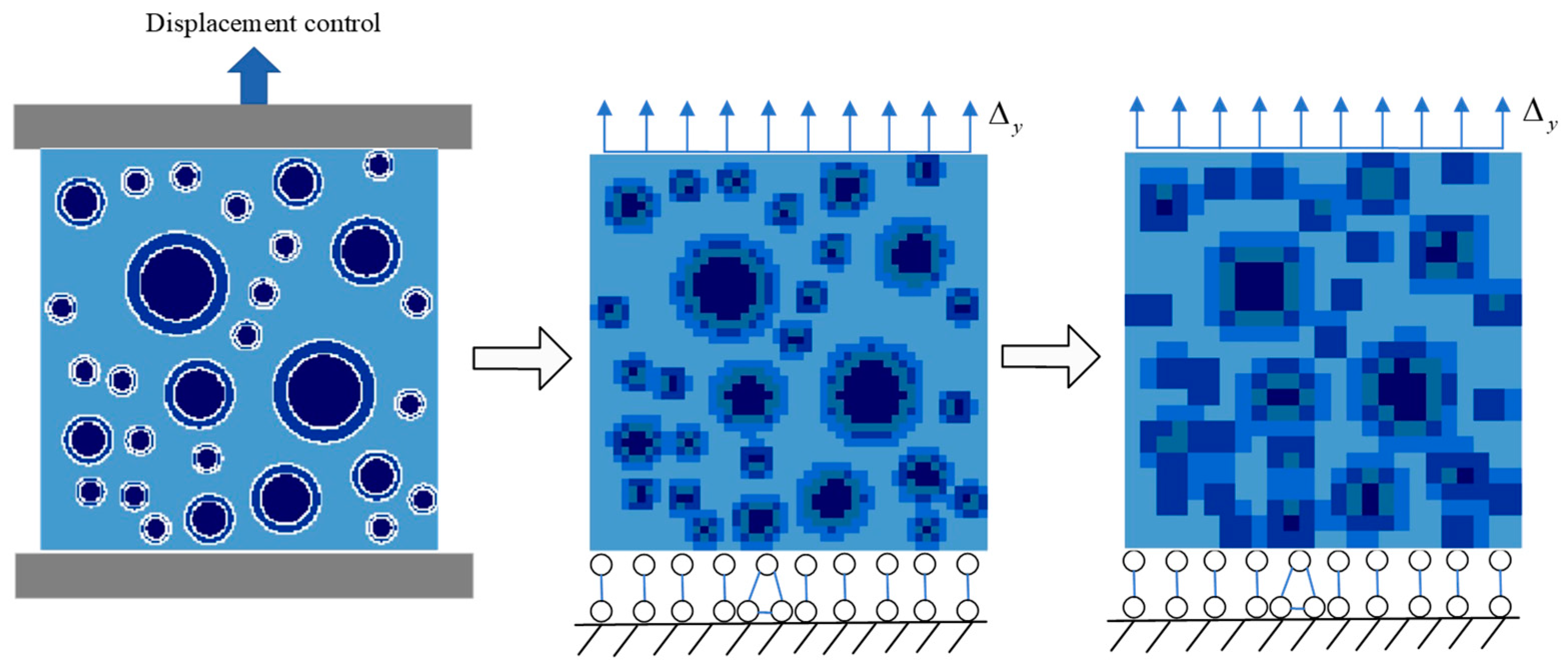

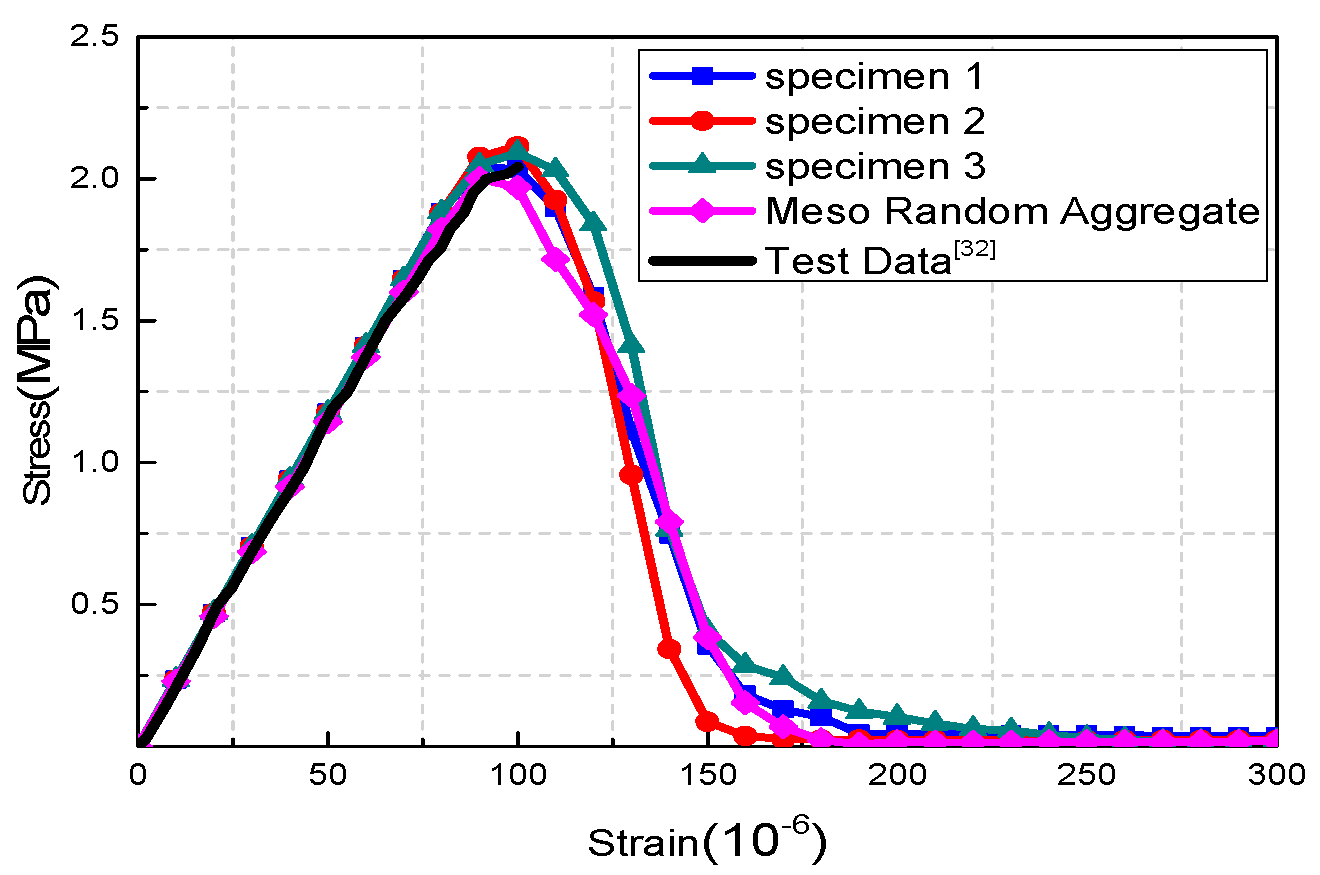
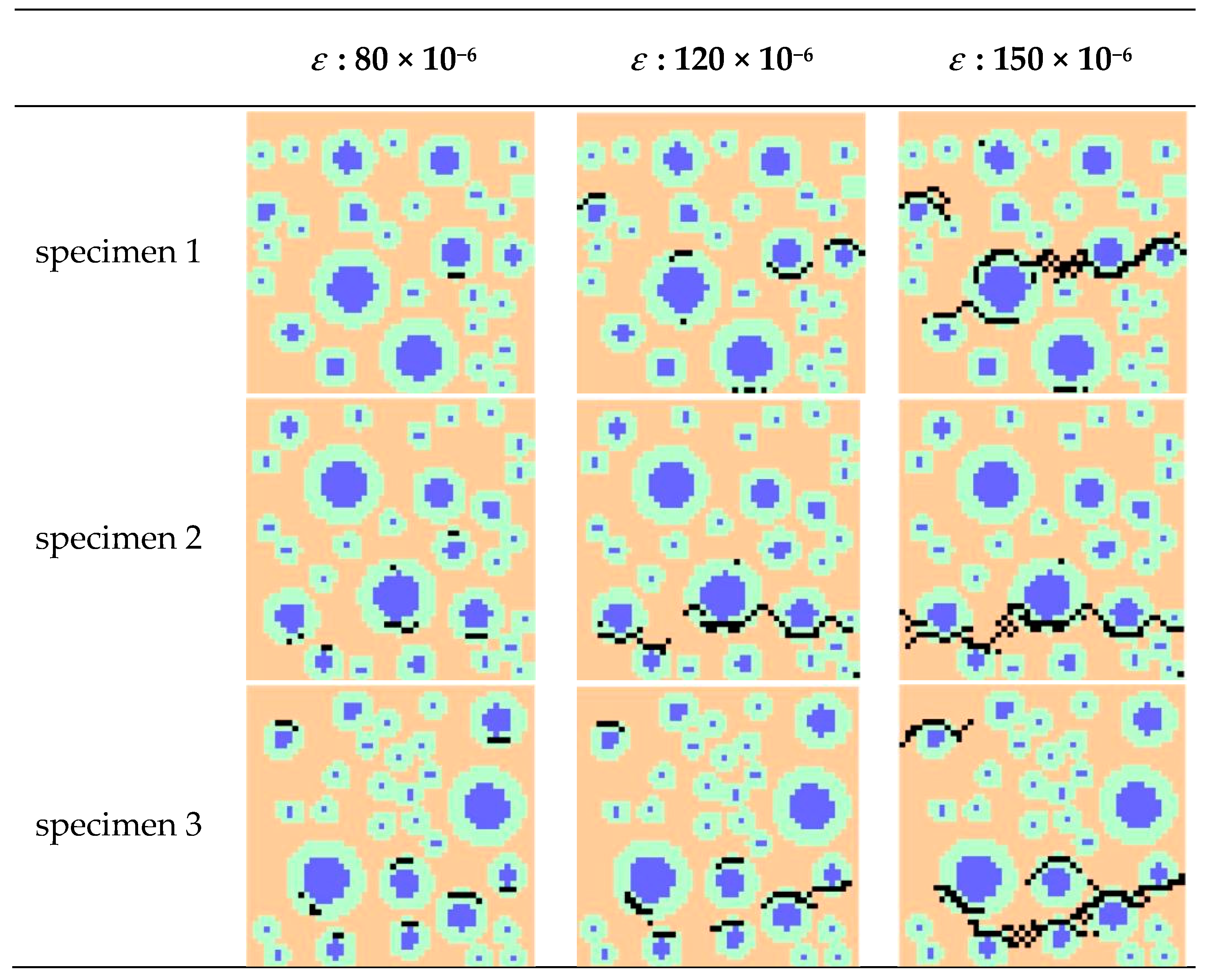
| Parameter | New Mortar | Recycled Aggregate | Old Bond Zone | Old Mortar | New Bond Zone |
|---|---|---|---|---|---|
| 0.25 | 0.65 | 0.23 | 0.25 | 0.23 | |
| 0.15 | 0.15 | 0.15 | 0.15 | 0.15 | |
| 0.13 | 0.25 | 0.15 | 0.13 | 0.15 | |
| 0.3 | 0.3 | 0.3 | 0.6 | 0.35 | |
| 4 | 5 | 3 | 4 | 3 | |
| 10 | 10 | 10 | 10 | 10 |
| Peak Strain (10−6) | Peak Stress (MPa) | |
|---|---|---|
| Test data [32] | 102 | 2.06 |
| Parallel specimen 1 | 100 | 2.10 |
| Parallel specimen 2 | 100 | 2.11 |
| Parallel specimen 3 | 100 | 2.09 |
| Model | Element Size (mm) | Element Number | Calculating Time of One Step (s) |
| Element of random aggregate model | 0.5 | 40,000 | 3062 |
| Element of homogenized equivalent model | 2 | 2500 | 10.8 |
Publisher’s Note: MDPI stays neutral with regard to jurisdictional claims in published maps and institutional affiliations. |
© 2021 by the authors. Licensee MDPI, Basel, Switzerland. This article is an open access article distributed under the terms and conditions of the Creative Commons Attribution (CC BY) license (https://creativecommons.org/licenses/by/4.0/).
Share and Cite
Peng, Y.; Zakaria, S.; Sun, Y.; Chen, Y.; Zhang, L. Analysis of Tensile Strength and Failure Mechanism Based on Parallel Homogenization Model for Recycled Concrete. Materials 2022, 15, 145. https://doi.org/10.3390/ma15010145
Peng Y, Zakaria S, Sun Y, Chen Y, Zhang L. Analysis of Tensile Strength and Failure Mechanism Based on Parallel Homogenization Model for Recycled Concrete. Materials. 2022; 15(1):145. https://doi.org/10.3390/ma15010145
Chicago/Turabian StylePeng, Yijiang, Semaoui Zakaria, Yucheng Sun, Ying Chen, and Lijuan Zhang. 2022. "Analysis of Tensile Strength and Failure Mechanism Based on Parallel Homogenization Model for Recycled Concrete" Materials 15, no. 1: 145. https://doi.org/10.3390/ma15010145
APA StylePeng, Y., Zakaria, S., Sun, Y., Chen, Y., & Zhang, L. (2022). Analysis of Tensile Strength and Failure Mechanism Based on Parallel Homogenization Model for Recycled Concrete. Materials, 15(1), 145. https://doi.org/10.3390/ma15010145







